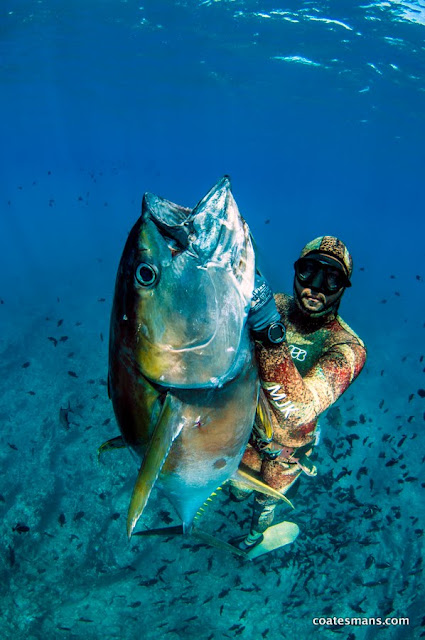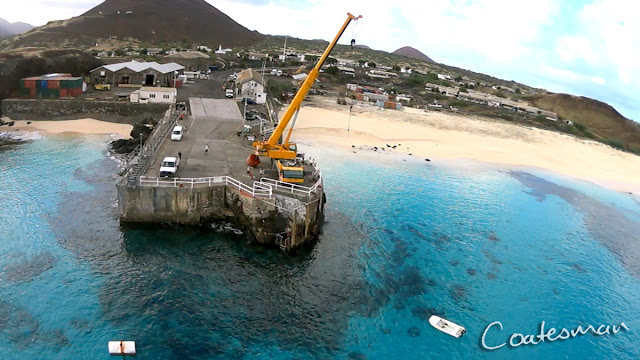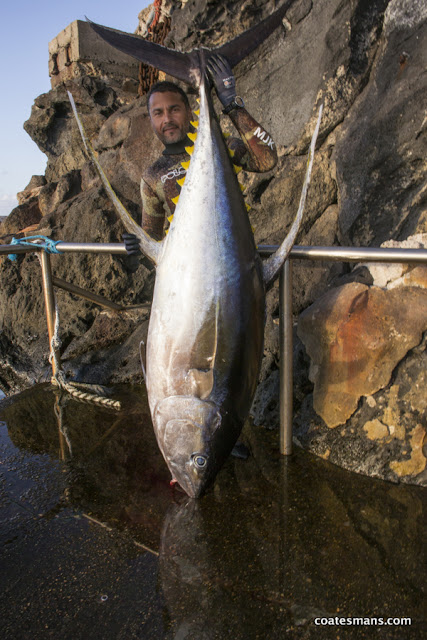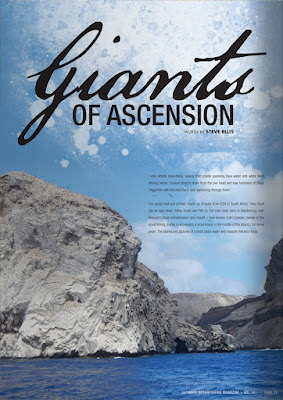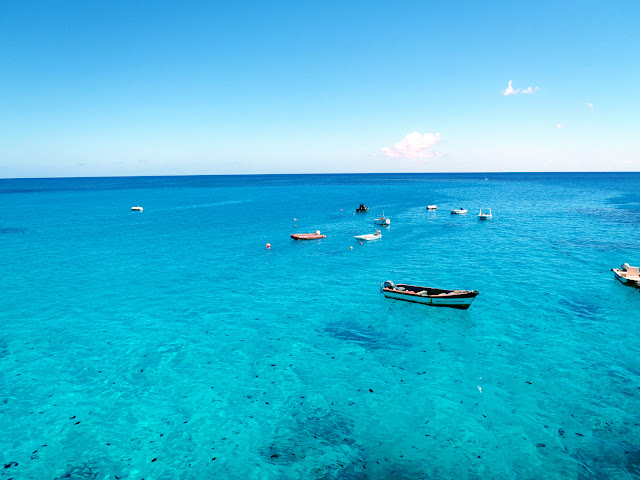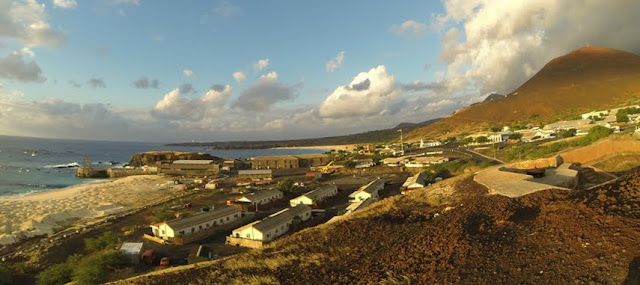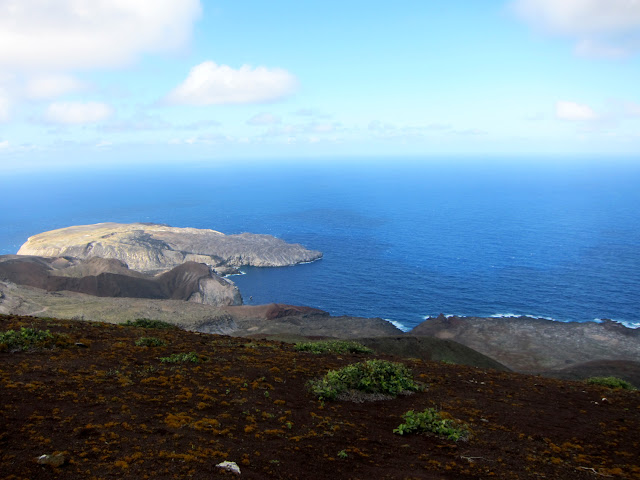Original article written for the Ultimate Spearfishing Magazine. - Words by Chris Coates
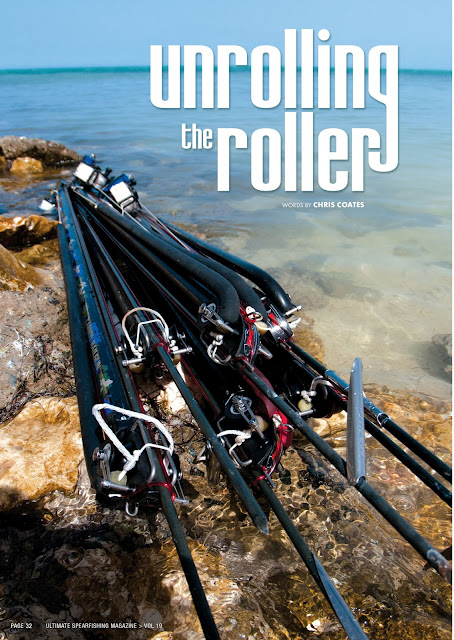 |
| Chris Coates's indepth Roller Gun Article published in the Ultimate Spearfishing Magazine |
About
18 months ago I was introduced to the crazy and ‘complicated’ concept of the
roller gun. Fueled by numerous online videos and chatter over the web, my
curiosity got the better of me and with the help from MJK in Qatar, we dived
head first into this latest fad. We made up a whole bunch of guns and after a
bit of a learning curve, we did a whole batch of tests. (see USM vol 14)
This
early testing proved that the roller guns had potential for greater speed and
power than conventional spear guns in a shorter gun. Setting the guns up was not nearly as simple
as what we were accustomed to. The more we used the guns and tried different
setups, from different muzzles to complete built roller guns from different
manufactures, the more we understood and became comfortable with the whole
concept.
Back
home, I started to sell the Power Roller Head kits as the interest in the
roller concept grew. The kits were great in that they came with a full set of
step-by-step instructions and all the bits and pieces you needed to convert
your conventional railgun into a roller gun. The problem was that I landed up
having super long discussions with each of the guys about how to set the guns
up. Just like I had with Emanuel, the manufacturer of the Power Roller Head
kits in the very beginning.
 |
| Early roller gun success, notice the long pretensioned rubbers. |
Despite
the step-by-step instructions (which most guys glossed over at best) and all
the phone calls, there were many who did not get the guns set up quite right,
and so they did not perform as expected. I also noticed that for the most part,
the online videos that you would see of guys using roller guns, the guns were
not set up properly. They would have very little pre-tension on the rubber, and
sometimes none at all.
This
lead to me rather building up the guns for the guys so that at least their first
gun would be setup correctly and they would have better chance at understanding
the whole concept. I hoped that in doing this, I would also reduce the learning
curve and the guys would start to see the full benefits of the concept right
away.
I
landed up making up a number of different setups as each guy had different
needs. The feedback I got made me realise that there were many ways to rig the
guns and sometimes what I initially thought was the right setup did not work as
well as expected. Some setups totally surprised me and way out performed my
expectations. This lead me on a quest to try fathom out, or at least try
quantify to some degree, the difference between the setups and guns with
something more than just presumptions.
The
three main variables that you have are the rubber being used, the length and
pre-tension of those rubbers, and the difference in rollers ie, bearings,
bushes etc.
The
first step was to better understand the rubber being used. Rubber is a fairly
complicated subject and actually deserves a whole article on its own. The
reality is that not all rubber is created equal. Much of what is marketed as “the
best” is only worth using as spear stop ends. The things to look for when
choosing rubber are as follows: It should be pure natural dipped latex with a
thin UV stable layer. Chemically cured
and extruded rubber does not have the same elastic properties of naturally cured
pure latex. The UV coating should also not be thick as this hinders elasticity.
Another
factor is age, rubber does not age well as it is a natural product and hardens
with time. This is also where the rubber with thick UV layers can be
misleading. The rubbers look fine but inside they are old, hard and for the
lack of a better word, have lost their ‘zing’.
I
bench tested the load capacities of various rubbers and thicknesses. The idea was
to establish the kilograms a rubber was pulling at specific percentages of
being stretched. I had been given stats by one of the manufacturers, but wanted
to do my own tests to verify what they were claiming. My findings were not that
far off, but I realised that because of aging and so many different types of
rubber, that I needed to stick to just one type for the tests. After all I was
testing the gun setups and not different rubber performance. I choose to use
Rob Allen latex rubber, mainly because of accessibility and the fact that I was
able to find out how old from date of manufacture the rubber was. This way I
was not testing old against new, which would skew the results.
Next
was to create a theoretical model using the information I had gathered from the
rubber tests and, using the potential energy equation, work out the kilogram
force centimeters potential energy. [Kilogram
force x distance] This can also be converted to Newton’s (Nm). This gets fairly
complicated, but simply, I was able to work out in a rudimentary way what potential
energy each of the different rubber lengths and pre-tensions of rubbers were
capable of producing.
I
basically had to calculate every possible variation for roller guns ranging from
800 – 1300 for rubber thicknesses of 14mm-18mm. There were so many variations on
each of the guns that I needed to have a separate spreadsheet page for each
length of gun and rubber thickness. A month and 18 spreadsheet pages later, I
moved onto conventional guns as a comparison. This is where things became very
clear to me. Firstly, all the conventional guns calculations for all the models
fitted onto a single spreadsheet page, smaller than one of the roller gun
calculations!
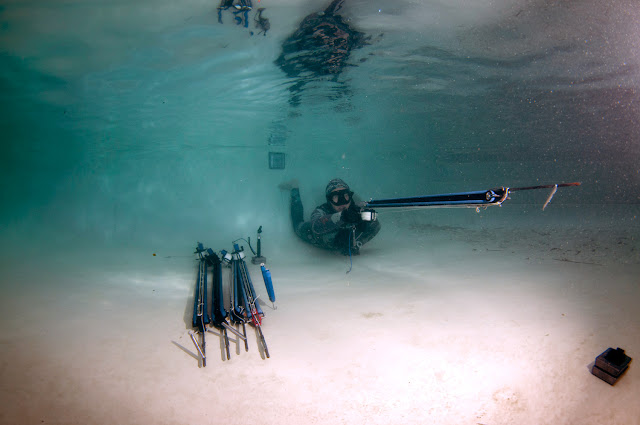 |
| Chris Coates putting a pile of roller guns through their paces |
This
is why roller guns are confusing. There are just too many different ways to
‘skin the cat’ so to speak. And which way is best?? The ‘potential energy
model’ I had built, although not perfectly accurate, gave me a fairly accurate
idea of what each different setup could produce.
The
next step was to distill the information into something practical that we could
test. I split the different setups into two groups - guns you can load by hand,
and guns you need to use a load assist with. The first group is simply the guns
that an average person can load by pulling on the extended bridle hoop. These
guns had a maximum of 20kg (less than 15kg is comfortable) tension on the
bridle at the muzzle. The second group is where you use a load assist to load
the gun becomes almost limitless. I say ‘almost’ as the gun is still limited by
what (kg) you can physically load at the notch. (Some other factors also apply which
we will discuss later on)
 |
| Hand loadable Roller with loading Loop |
Hand Loadable Roller Guns
With
the hand loadable guns, there are a few ways to set the guns up. Logically, the
idea is to have the least amount of tension at the muzzle (so you can pull the
bridle off the muzzle) and still have the rubber stretched to its optimum,
which is between 350% and 400%.
Basically the concept works as follows: the shorter the rubber the least
amount of load / pre-tension is needed to have the rubber at 400% when loaded
at the notch. So, less pre-tension means lighter load on the bridle at the
muzzle, and therefore it will be easier to load. The longer the rubber, the
more pre-tension you need to stretch the rubber to 400% when loaded on the
notch, and hence more load on the bridle at the muzzle.
This
means that with a shorter rubber with a short pre-tension, you can easily pull
the bridle off the muzzle but it very quickly becomes harder to pull and pretty
hard at the notch. The magic ratio that
I came up with was to have the rubber 38% of the barrel length with 140%
pretension. This would give you the least amount of load at the roller and
maximum at the notch. IE. On 100cm gun you have a 38cm 16mm rubber with +40%
(15cm) pre-tension you will have a gun with only 9kg load on the roller muzzle
and a whopping 60kg (400%) at the notch. [Potential energy kg/cm = 3908]
As
you can see, the 60kg is fairly hard to load and not everyone will be able to
load a gun like this. (Approximately the same as loading a conventional 130cm gun
with a very short 20mm rubber)
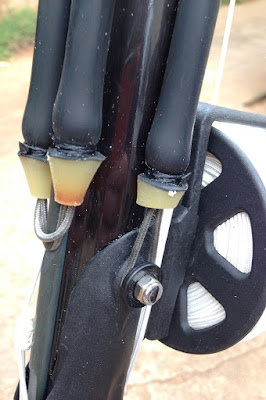 |
| Roller rubbers tensioned all the way to the luggs. |
On
the other extreme, you can make the rubbers longer and stretch them all the way
to the lugs on the handle. But, in order for you to be able to load the gun by
hand, the rubbers need to be long enough to reduce the load to below 20kg (Note:
In practice 20kg was the limit I was able to pull the bridle off the muzzle by
hand but 15kg is more practical) This means that the load at the notch will be
lower. IE. On 100cm gun if you have a 70cm 16mm rubber pretension all the way
to the handle, you will have a gun with 18,6kg load on the roller muzzle and
only (285%) 42,6kg load at the notch. [Potential energy kg/cm = 3987]
Theoretically,
this should perform similar to the previous setup, but it would be a lot harder
to pull the bridle off the muzzle.
Then
there is the middle ground, somewhere between the two extremes. This is where
you find a happy medium between rubber length and the pre-tension so that the
gun is comfortable to load. IE. On 100cm gun you have a 55cm 16mm rubber with +40%
(22cm) pre-tension, you will have a gun with 15,6kg load on the roller muzzle
and (321%) 46kg load at the notch. [Potential energy kg/cm = 3853]
This
setup is similar to the setup recommended by Manny Sub, the manufactures of the
Power Roller Head, and has already been proven to be very effective.
Now
all three setups all produce similar kg/cm potential energy and theoretically
should all perform equally as well. Each
setup had its pro’s and con’s, from loading to performance. This was the first
aspect I wanted to test in the pool. I chose to use a 110cm gun to test, as it
would fit in with other tests I wanted to do and it is also one of the most
popular length guns being used. The lengths of rubber were calculated by what
should be loadable by hand.
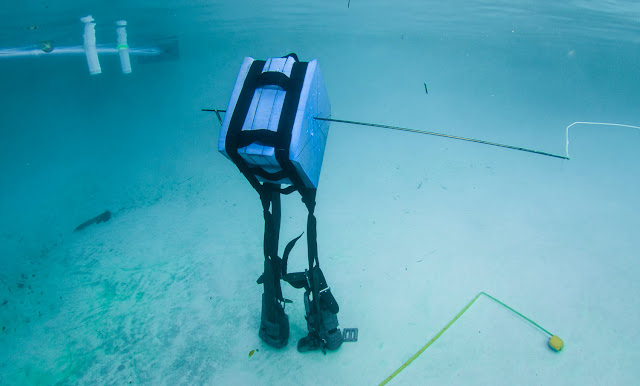 |
| Thick EVA foam used for roller gun experiment. |
The
tests were done in a pool using a 26cm thick solid EVA block at a distance of 4m
from the end of the spear. (Approx. 6m
diver) Each setup was tested 2-4 times, taking an average of the 2 most
consistent results of how deep the spear penetrated the foam block.
Rubber
|
Result
|
|
Std
|
34cm
|
16mm
@ 60cm + 18cm pretension (12,5kg -43,5kg = 3765 kg/cm)
|
Full
|
28cm
|
16mm
@ 80cm full pretension (15,3kg -37,9kg = 3772 kg/cm)
|
Short
|
34,5cm
|
16mm
@ 42cm + 6cm pretension (6,9kg -55,7kg = 3820 kg/cm)
|
The
shorter rubbers performed better than the longer fully stretched rubber; possibly
due to two factors. The first is that the 80cm rubber is not working at its
optimum 300-400%. Secondly is the fact that it does not have as high notch load
as the others. This is all even though a similar amount of total potential energy
is being used.
Theoretically,
in perfect situations, if you drive a spear with the same amount of kg/cm,
regardless of where the energy is released, they should all have the same
velocity. This test showed that there are other dynamics at play, and so the
results were vastly different.
The
gun that felt the best however was the 80cm full tensioned gun. The 42cm short
setup had noticeable recoil, not as much as a conventional gun but more than
what I am used to. It was also the hardest to load, even though the bridle came
off the muzzle the easiest. The 60cm std. setup in this scenario worked best,
with good performance and no recoil.
14mm Vs 16mm
Next
was to test a 14mm and 16mm fully stretched rubber scenarios that should be loadable
by hand. Working on the 20kg muzzle load limit, the rubbers were calculated to
a similar kg/cm potential energy. This would be a good comparison to the
previous test and also compare the 14mm and 16mm in a similar power setup.
14mm
Vs 16mm
|
|
|
|
|
|
Rubber
|
Result
|
|
|
|
|
|
14mm
|
32,0
|
14mm
@ 55cm full pretension (20.9kg -45,8kg = 4818 kg/cm)
|
16mm
|
40,5
|
16mm
@ 70cm full pretension (18,9kg -43,8kg = 4482 kg/cm)
|
The
16mm full tensioned rubber performed very well, by reducing the length of the
rubber by 10cm it had a massive improvement in performance. Unfortunately the
gun was almost impossible to load by hand, and after the first shot I used the
load assist to load the gun.
The
14mm worked very well if you consider that it was not that difficult to load by
hand. Although it did not compare to the 16mm in penetration, it did fairly
well against the previous 16mm tests. If you consider that 14mm rubbers are
easier to load than the other 16mm rubber setups tested, then the 14mm rubbers
to me was the most practical. The gun also just felt really good and was very
accurate.
Load Assisted 18mm Setup
The
next step was to test an 18mm rubber powered to 366% on a full pretension. Theoretically
you could get better performance by going to 400% stretch or adding an
additional rubber. This was the length rubbers that I had been using and found
to be well balanced.
I
also wanted to compare the difference between the 7mm and 7,5mm spears.
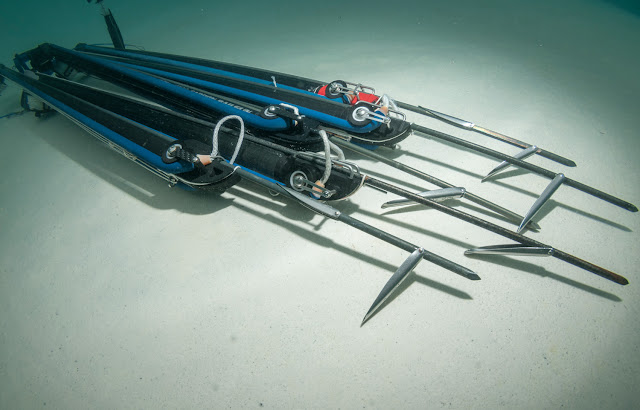 |
| Some of the roller guns made up for the test. In total 10 guns were made up for the experiment. |
18mm
Rubber Load Assist - 7,5mm Vs 7mm
|
18mm
@ 60cm Full T (32kg -68,4kg = 7281 kg/cm)
|
Spear
|
Result
|
7,5mm
|
53,0
|
7mm
|
45,0
|
Although
this is a very tight rubber, it is not that difficult to load using a load
assist. When you pull the trigger, you definitely know that you are shooting a
much more powerful gun. The 7,5mm spear performed well as expected and went
through the 53cm block of foam. The spear had dropped a few cm but from
previous tests, I had expected this. Bear in mind that at 4m from spear point
(6m from diver), there are not many situations where you will take a shot at a
fish over this distance.
The
7mm spear on the other hand was a bit disappointing as far as penetration goes
and only went through 45cm, only 5cm more than the 16mm rubbers. It was however
accurate and fast, so it is an effective setup.
Just
as a comparison I took shots with a 1300 Rob Allen with 2 x 14mm rubbers at
70cm and a 1,8m 7mm shaft. The 1300 conventional gun performed as expected and
penetrated the target 45cm.
This
was not a surprise as we had done this side by side comparison before (see USM
Vol 14). What was interesting, was the fact that the gun had noticeable recoil
in comparison to the roller guns. The recoil was probably more noticeable
because I have not used a conventional spear gun in while and was no longer used
to the way the gun fired.
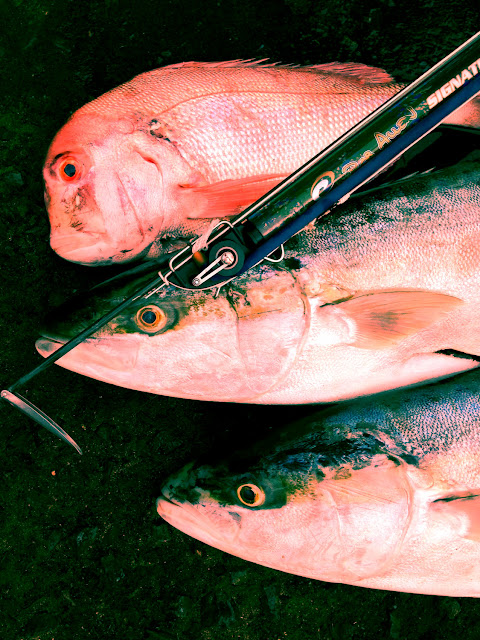 |
| 1100 Roller Gun with std plastic bearings doing the job. |
Ceramic Vs Standard Bearings
The last thing I wanted to test was the difference between the standard bearings made of acetyl nylon with encapsulated glass balls and full ceramic bearings. There have been a few guys that have already tested and proven that the standard bearings outperform rollers with bushes, so logic suggested that by improving the bearings you would improve performance.
The reason why the bearings effect performance is that there is a certain amount of inefficiency and slowing of the rubber contracting as it changes direction around the roller. Improve this and you should improve performance. While researching this on the web there, I found so many different theories on this point alone (some even saying that it would make no difference at all) that a test was needed to get a conclusive answer.
The test was done using the exact same rubbers and spears on an identical gun, just with ceramic bearings. The test was done as before at 4m spear tip, and the rubbers were alternated between guns so that there was no advantage or disadvantage by being used first or last.
Bearing:
Standard Vs Ceramic at 4m
|
|
Rubber
|
Std.
Bearing
|
Ceramic
|
|
14mm
|
32
|
35,5
|
14mm
@ 55cm full pretension (20.9kg -45,8kg = 4818 kg/cm)
|
18mm
|
45
|
47
|
18mm
@ 60cm full pretension (32kg -68,4kg =
7281 kg/cm)
|
The
comparative tests were conclusive that the ceramic bearings did improve
performance. Albeit only a marginal improvement, there is enough of an
improvement to make it a worthwhile upgrade if you have the money. Take for
instance that the 14mm with the ceramic rollers outperformed the 16mm std.
setups with the standard bearings.
This does however raise the question of how well are other rollers with
inferior bearings or just plain bushes performing?
Can You Over Power A Roller Gun?
Overpowering
a roller gun has always been something in the back of my head. But because of
the low recoil and the fact that even with high powered guns, the shaft leaves
the muzzle before the muzzle lifts, I did not consider overpowering a problem.
This however came into question when I moved the target to 5m from the spear
tip when comparing the bearings. (NB 5m from spear tip is approx. 7m from
divers mask, this is an extreme distance and not a practical hunting distance.
Most divers will never take a shot at this distance, especially with a 1100)
Bearing:
Standard Vs Ceramic at 5m
|
|
Rubber
|
Std.
Bearing
|
Ceramic
|
|
|
|
14mm
55cm full
|
22
|
24
|
14mm
@ 55cm full pretension (20.9kg -45,8kg = 4818 kg/cm)
|
|
16mm
63cm full
|
25
|
24
|
16mm
@ 60cm full pretension (25,2kg -52kg = 5634 kg/cm)
|
|
18mm
62cm full
|
25
|
23
|
18mm
@ 60cm full pretension (32kg -68,4kg =
7281 kg/cm)
|
|
|
|
|
|
|
|
|
I
first tested the 14mm rubbers against the 18mm rubbers and when the results
came out so close together, I added in the 16mm rubber bands. Shockingly, the
ceramic bearings that had been better at 4m had now performed worse than the
std. bearings. The 14mm however had improved with the ceramic bearings, and had
even beaten the 18mm rubbers. The results got worse with the more power that
was going into the spear.
I
took this conundrum to Jeremy Williams from the Dive Factory who is a qualified
engineer and in my opinion, is one the best minds in the industry. He said it
is probably increased friction caused by the shaft vibrating or wobbling with
increased velocity. The ceramic bearings being more efficient, drive the shaft
a greater velocity and overpower the shaft. This is something that also occurs
with bow hunters when they don’t match the arrow shaft with strength of their
bow. There are also other factors like increased drag resistance the faster the
shaft travels. Basically, a shaft leaving the gun at twice the velocity of another
shaft will not travel twice as far, as the faster shaft will have an increased
amount of drag which becomes exponential the faster you go.
The
way to overcome this, is by increasing the stiffness of the shaft. This can be
achieved by either shortening the shaft or going thicker. On roller guns, the
shafts are already shorter than conventional guns and one could surmise that
the roller gun in this instance should be better.
A
7.5mm shaft is the other option, but then there is greater drag and weight
which will need to be taken into consideration.
Before
I can come to a conclusion on these theories, they will need to be tested. The
things I need to test are the difference between shaft lengths and thicknesses
with guns that are at full or maximum load. I think for now it is safe to make
the assumption that if you are going to go for a high powered roller gun, that
you should keep the shaft shorter and go up to 7.5mm thickness.
It
is also good to bear in mind that you need to keep this example in context of
the size of the gun (1100) and what it is already achieving. As in previous
test, the 1100 roller out performed all the conventional 1300 guns at 5m from
the spear tip (see USM Vol 14). What is interesting, is how well the 14mm gun performed,
especially with the ceramic bearings. This has really given me even greater
confidence in this setup.
Conclusion
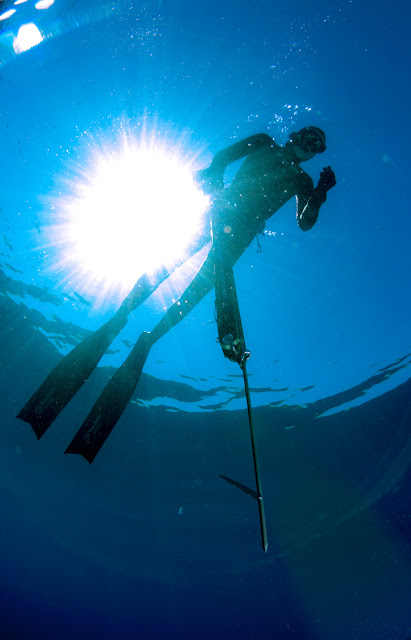 |
| A Rob Allen Prototype Roller Gun with Ceramic Bearing |
It
is still difficult to come to a decisive conclusion on what the ultimate setup
for roller gun is. Each person reading this will have come away with a different
perspective according to what their spearfishing environment is like, and what
their needs are. With some scenarios, certain
setups are more apparent, like if you want as much power as you can get, then
18mm rubber full pretension to over 360% is going to give you what you need.
If that’s not enough, then just like with any other spear gun, there is a time
when you have to go longer to get more. I think in many cases, a slightly
longer well balanced gun is better than trying to get too much out of a short
speargun.
With
other set ups it is going to be up to personal preference, and what each person
can practically load. It is finding the balance between ease of loading and how
much power you need. I think that many guys, myself included, underestimate the
roller guns at first and go for more power than they really need.
Since
doing this exercise and rubber test I have come to certain conclusions based on
what I have found out. They might not be what some guys would recommend, but
based on my needs, this is what I have personally changed my guns to. I hope
this will give you an idea on how and why I use certain guns setups.
As
in the test I have separated my guns into hand loadable guns, which are ideal
for shore diving and competition scenarios where you want to be quick and
efficient. I then have rubbers setups that need a load-assist. These are great
when targeting specific species where extreme power is needed.
My Hand Loadable Set Ups
Gun: 900 Carbon Rob Allen
Rubbers: 14mm @ 45cm
Pretension: Maximum
Spear: 1.3m 6.6mm shaft – double wrap 1.8mm Dyneema
My
900 is probably one of my favorite guns, I am constantly surprised at how well
this little gun performs. It is fairly easy to load by hand and is just crazy
good to shoot. I use this gun mainly for reef species and is basically my
replacement for my std. 1100 with a single 16mm rubber and 7mm shaft. That said,
this gun would probably out shoot most single rubber 1200 guns. I use a 6.6mm
shaft as it is quick and accurate to the end of a double wrap. It still has
loads of punch and it even went right through a 35kg Daga Salmon (Mulloway) when
used for a second shot. The shot was not close and went in mid way and out the
gill plate on the other side!
Gun: 1100 Carbon Rob Allen
Rubbers: 14mm @ 55cm
Pretension: Maximum
Spear: 1.5m 7mm shaft – double wrap 1.8mm Dyneema
This
is my other favourite gun. The 14mm rubbers make this gun loadable by hand even
with the rubbers loading at 400%. Like with the 900, the 14mm rubbers are so smooth
and it is just such a joy pulling the trigger. This is my all round gun and I
use it for reefies in clean water, and if a good size gamefish comes past, I
know I have more than enough power and range to get the job done. This gun has
pretty much replaced my standard 1200 with single 18mm rubber and 7mm shaft.
I
have chosen to go with the 14mm rubbers over the 16mm rubbers that are also
hand loadable, even thought the 16mm have better performance. The 14mm rubbers
are marginally easier to load, especially off the muzzle. I also like the fact
that there are no strings to wrap around the lugs to pretension the rubbers. It’s
very quick and convenient to just pull the rubbers down and onto the lugs when
I go dive. Plus the 14mm rubbers on the carbon barrel just feel really amazing,
and there is no recoil at all.
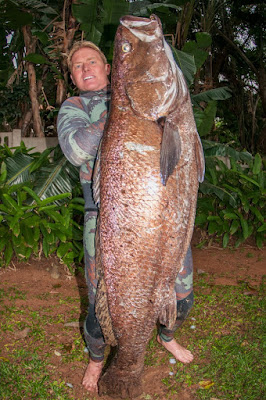 |
| 35kg Daga taken with a 1100 / 16mm rubbers |
My Set Ups Using a Load Assist
Gun: 1100 Aluminum Rob Allen
Rubbers: 18mm @ 60cm / 16mm @ 60cm
Pretension: Maximum
Spear: 1.5m 7. 5 mm shaft / 7mm shaft – double wrap 2mm Dyneema
This
was my first roller gun and I have kept it for my more powerful setups. If I am
hunting Daga and need of maximum power, then I switch to the 18mm rubber and
7,5mm shaft. If I am hunting gamefish and need speed, accuracy and distance, I
put the 16mm rubbers on and change to the 7mm spear shaft.
This
is where the roller gun becomes very versatile as I can swap out rubbers and
spears in a minute or two and have a totally different gun.
Gun: 1200 Aluminum Rob Allen
Rubbers: 18mm @ 65cm / 16mm @ 60cm
Pretension: Maximum
Spear: 1.6m 7 mm shaft – double wrap 2mm Dyneema
I
made this gun up as a blue water gun, specifically for fish like Wahoo and Couta. I tried 18mm rubbers but only had a
7mm shaft and missed twice on long shots on Kakaap. The shots were long, difficult, and I probably
would not have attempted the shots had I been using a standard 1300, so it is
difficult to read too much into the 2 fluffed shots.
I changed to the 16mm (took the 60cm rubber off the 1100) and the gun shot
really well with the 7mm shaft, and I shot a number of good sized Couta and
Tropical Amberjack. I was enjoying this setup, so I just stuck with it.
The
16mm rubber and 7mm shaft setup is nicely balanced. I think the high powered 18mm
starts to overpower the 7mm shaft and it might be starting to wobble or
vibrate. This is only an assumption at this point and I need to try the 18mm
rubbers with a 7.5mm shaft.
 |
| MJK Marlin using 1300 MAMBA Roller gun |
Gun: 1300 Aluminum / Carbon Rob Allen &
Carbon Mamba Barrel
Rubbers: 18mm @ 75cm - 70cm
Pretension: Maximum
Spear: 1.7m 7.5 mm shaft – double barb - double
wrap 2mm Dyneema
I
have made a number of these canons to take on trips, and am still to come home
with one. This is mostly from guys who have large multi rubber guns who see what
the rollers can do and then won’t give them back.
I have made variations with Aluminum, Carbon and Mamba barrels. My favourite
without a doubt is the Custom Mamba. I think the extra volume and weight give
the gun the right amount of inertia with the high powered 18mm rubbers. The E.X.
Rob Allen Carbon barrel is great because it is so light that it makes the gun
feel a lot smaller in the water. This helps with minor recoil that this canon
is going to have. I found the gun is a bit buoyant at the muzzle and could
cause you to shoot a little high, adding a little lead in the muzzle sorted
this problem out easily. NB - this buoyancy is something you need to consider
with carbon roller guns
I
often get asked if this is the ‘ultimate’ blue water gun. It is difficult to
say, as you can find more powerful guns out there. But, you have to consider
the size of the gun and ease of diving with it. When you take that into consideration,
I can’t think of a better setup. The
down side, if there is one, is that this gun is not easy to load at full power,
even when using a load assist (which is essential). Some guys drop it down a
notch so that it’s not so intense. Craig Heslop recently took one to Latham
Island for doggies and in his pre-trip pool tests, he was accurate at a
whopping 9m with the gun. And that was not at full power…
Final Comments
You
probably noticed that all the guns I currently have setup, are all full pretension
rubbers that don’t use the standard line that is wrapped around the lugs to
pretension the rubbers. I just find them a lot less of a hassle and I can
change out the rubber quicker if need be. It’s also easier to just pull the
rubbers off the lugs when the gun is not in use, as apposed to unwinding the
strings and loosening the rubbers that way.
Also,
when using a load assist, it just makes sense to maximise your power, and the
only way you will get more power out of a standard pretension rubber, is to go
over 400% stretch which is not advisable as this will just reduce the life of
the rubber dramatically.
With
the hand loadable guns, you could go with the 16mm standard setup and this
works well, as proven in the tests. The advantage is that you are only stretching
the rubbers to 300%, so they should last longer than using the 14mm rubbers
stretched to 400%. Again, the ease and simplicity of no strings makes the 14mm
a winner and it just looks better, if that has any value.
As
far as the bearings go, ceramic bearings are definitely worth investing in. The
guns I have been using them in have been brilliant and the hard ceramic bearings
show no signs of deterioration from sand or general wear and tear. I think they
will have a longer life span than the standard bearings, but only with time
will we know for sure if this is the case.
I
hope that this article has helped shed some light on many of the questions
surrounding roller gun setups, and which setup will suit your needs best. There
are still some things that need to be ironed out, like the potential ‘over
powering’ issue and what spears are best suited to solving that problem. But in
the meantime, there are setups that are proven to work incredibly well and I
think this problem only really effects guns where guys might be wanting to get
too much out of the gun.
I
think that the biggest thing you need to take away from this article, is of how
well some of the setups perform and how versatile one gun can be. I am
definitely going to be doing more experimenting and I am sure I will find some
more gem setups for my arsenal.
Cheers
Chris Coates
